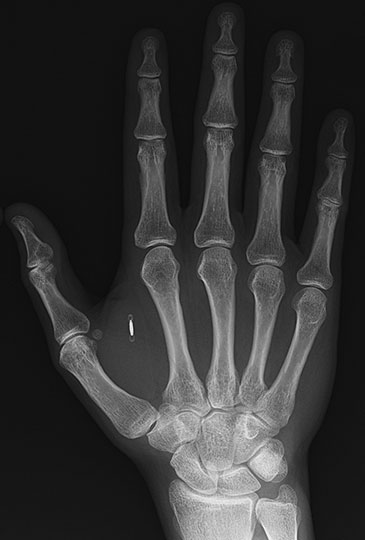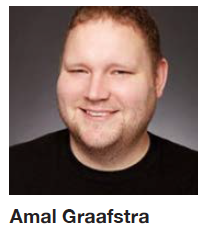Future Now
The IFTF Blog
Altered Anatomies
Co-authored with Alessandro Voto
Voices from the Vanguard of Implantable Tech
Implanting a computer chip in your body today is no easy task.
 Unless it’s part of a prescribed medical procedure, it often involves breaking the law and always involves breaking the skin. Still, a small but significant number of people are hacking their bodies with DIY implants—and their experiences offer valuable clues and insights about how to navigate a world in which implantable computing is commonplace.
Unless it’s part of a prescribed medical procedure, it often involves breaking the law and always involves breaking the skin. Still, a small but significant number of people are hacking their bodies with DIY implants—and their experiences offer valuable clues and insights about how to navigate a world in which implantable computing is commonplace.
To get a preview of this future, IFTF’s Eri Gentry and Alessandro Voto sought out two pioneers in this space, Amal Graafstra and Seth Wahle, who are exploring the future of implantables by testing them on their own bodies.
Amal, an avid DIY body hacker, discovered the means and inspiration for his RFID implant at his workplace. In 2005, managing IT systems for medical centers, as he carried boxes of hardware, he felt frustrated by key-based door access.
“Why am I using this 13th-century technology, a hunk of metal cut in a certain shape, to get in this door?” he thought. ‘I could get RFID on my door. How do I get rid of the card? Oh, pets have this chip inside them.’ I ordered a bunch of the tags. And within a few days was in my doctor’s office saying, ‘Put this thing right in my hand.’ He was like, ‘Well, what is it?’ I said, ‘It’s like the chips pets get in the neck, but I want it here so I can get in my door.’ He’s like, ‘That sounds cool,’ and he does it.
“We all understood that the body is this machine, and you can upgrade it. Its purpose is to move your mind, your consciousness through this universe and experience it and influence it. And if you get an upgrade and improve your quality of life, that’s great.”
Why Not a Wearable? Staying Connected, Staying Free
 “A good implant,” Amal explains, “becomes so integrated with your daily life that it disappears. It’s unmanaged. You think about it about as much as you think about your kidneys doing their job. Every time I come home, I go to my door, I swipe, I grab the doorknob. I don’t think about it at all.”
“A good implant,” Amal explains, “becomes so integrated with your daily life that it disappears. It’s unmanaged. You think about it about as much as you think about your kidneys doing their job. Every time I come home, I go to my door, I swipe, I grab the doorknob. I don’t think about it at all.”
Amal contrasts the simplicity of his implant with the complexity of today’s device ecosystem. “We have to manage a lot of things. Is my FitBit on? Is it charged? Everything you have to apply to your person when you get out of bed in the morning is management, and it’s annoying.
“Picture leaving the house with no keys, no wallet, and no phone, you’d be like, ‘What if I get locked out? What if I need money for the train?’ It’s this anxiety that your tools aren’t with you, and you can’t survive in the world. [For] people who can overcome that for even a short time...it feels like freedom.”
Connectivity, Stealth, and Competitive Advantage
 Seth Wahle came to implants with different experiences and a different mindset. A former Navy technician and avid hacker, he has a deep appreciation of the hidden security risks of implantables—and an appetite for self-experimentation. Without access to a willing doctor, he contacted a tattoo artist on Craigslist who placed the NFC chip in his hand.
Seth Wahle came to implants with different experiences and a different mindset. A former Navy technician and avid hacker, he has a deep appreciation of the hidden security risks of implantables—and an appetite for self-experimentation. Without access to a willing doctor, he contacted a tattoo artist on Craigslist who placed the NFC chip in his hand.
Seth soon realized that he could perform a “parlor trick” by picking up people’s phones and bringing up a webpage by sending an address from his hand.
A local hacker group inspired him to use this trick in a dramatically new way. Hack Miami had just proved to national media that a Wi-Fi router could be installed to secretly hack over 380 people’s phones. Seth told the group’s organizer, “I can trigger a download with a chip in my hand.” He proved his point by asking for people’s numbers and infecting their phones with malware.
What do his implants mean to him now? Seth says, “It’s about stealth. I can execute code silently. It kind of tied into my whole theory of bio-hack, why I would want to implant devices. I have something which allows me to interact with machines like no one else can.” While implantables are, of course, internal devices, they have the potential to transform our relationships to our environments. Seth expressly wanted his implant to have the function of a compass.
“It could be a survival plus one,” he said, citing it as an example of a use for the technology that would be subtle and unobtrusive, but hugely important in an emergency situation.
Whether for crisis response or exploration, body area networks are set to dramatically impact our lives and the way we experience them. Amal observed that a magnet implanted in his hand allowed him to literally feel when he was close to different kinds of metals.
“I came home with my magnet in my finger and [used a heat sealer device]. It buzzed really strongly. In only a matter of days, my brain was already starting to interpret, ‘This means something about the environment around me.’... [It opens me up to a whole] universe I’ve never known before.”
 FUTURE NOW—The Complete New Body Language Research Collection
FUTURE NOW—The Complete New Body Language Research Collection
The New Body Language research is collected in its entirety in our inaugural issue of Future Now, IFTF’s new print magazine.
Most pieces in this issue focus on the human side of Human+Machine Symbiosis—how body area networks will augment the intentions and expressions that play out in our everyday lives. Some pieces illuminate the subtle, even invisible technologies that broker our outrageous level of connection—the machines that feed off our passively generated data and varying motivations. Together, they create a portrait of how and why we’ll express ourselves with this new body language in the next decade.
For More Information
For more information on the Tech Futures Lab and our research, contact:
Sean Ness | sness@iftf.org | 650.233.9517



